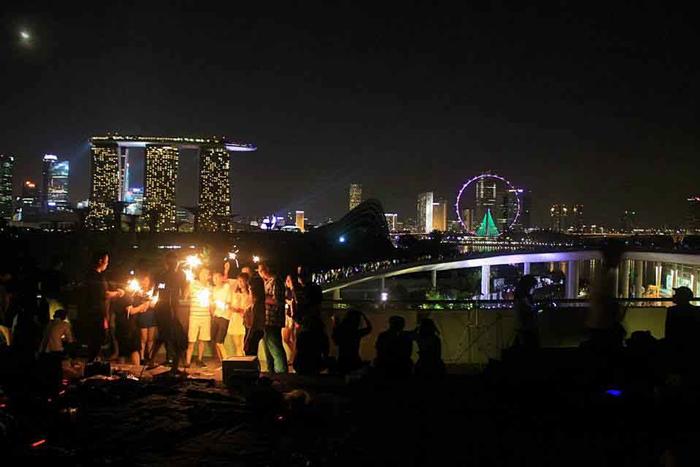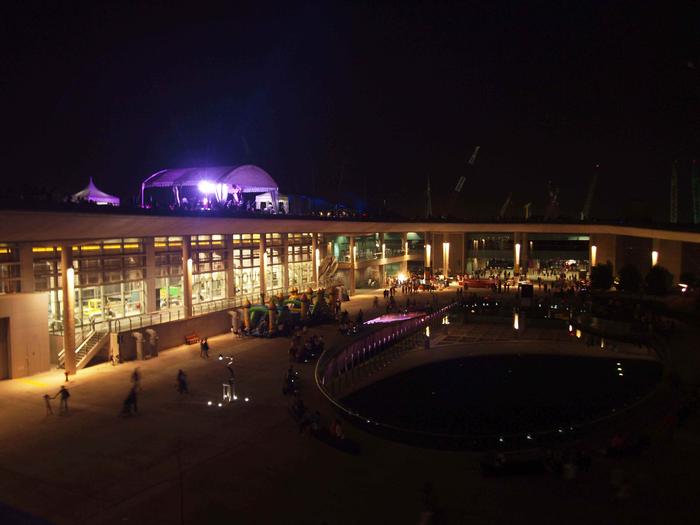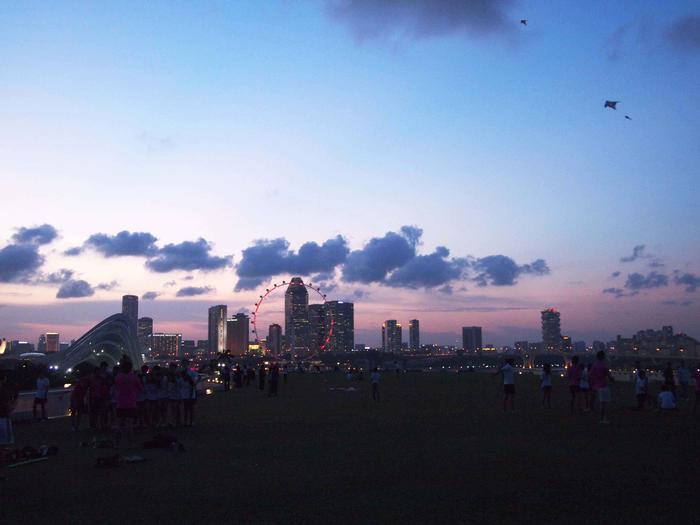Loh Kin Kit and Yen Shan Phoaw EssayThe greatest public good is public spaceBefore anything can be built upon reclaimed land, the land must lie fallow for a period of time. This process created a unique situation. For as long as we could remember, there sat a large stretch of reclaimed land that lay across a river from the city center. Every weekend, we could see from a nearby flyover a lively scene as people gathered there to fish and fly kites on that open field. Nothing could have been stranger than to see this almost rural scene laid out against the backdrop of silver towers gleaming in the distance, a feeling that was even more significant for having happened here in Singapore. We live in a meticulously planned city. As Chua Beng Huat1, a local scholar writes, “Singapore is already a fully conquered island in the imaginary, in that every foot of space is already assigned to a particular use…. No space has been left to chance, and even nature has to have the permission of the planning agencies to survive.” Such scenes as we remembered then begin to take on a rare and unexpected quality. It is heartening to see how a vacant field may find its use even if it has already taken on the life of a building in the projections of the city’s planners. It was only natural that in time, the temporary lease of life for the reclaimed land expired and was replaced instead by a frenzy of construction. As part of the Marina Bay Area, it was a part of a massive project to transform the city center into a waterfront financial hub. But as the construction work commenced, we felt as if something was being lost for good. It was encouraging then, to see the construction in 2008 of the Marina Barrage by Architects Team 3, a local firm with a long history in public buildings. Built as a dam and a ‘lifestyle hub’, the Barrage is a curved concrete ramp that shelters under it the essential equipment for the dam, its raison d’etre that has allowed the reclamation of that original scene. Atop the ramp is a vast field looking out towards the sea, on which people from all walks of life may once again enjoy the activities that used to take place there. The quality of the place that emerges, almost as if out of happenstance is what makes the Marina Barrage different from any other place in Singapore, and lends it its unique public significance. The purpose of the Barrage is primarily to function as a dam. The Marina Barrage serves to seal the channel into the Singapore river, in order to create an artificial reservoir in the heart of the city. The creation of this artificial water body intends to increase Singapore’s water supply by 10% as well as provide an ideal venue for water activities (boating, windsurfing, dragon boating, etc.). Various water sporting events have been held since its inauguration. The new waterfront venues created as part of a master plan for the area have also become of national significance; the annual National Day celebrations are now held at the Marina Bay floating platform. The iconic Marina Bay Sands casino also fronts this water body. The Barrage thus serves as an important part of the island nation’s plan to enliven the heart of the city. But very much aside from fitting into this grand vision for the city, the Barrage is also a piece of architecture that is intended to serve the public. The architects have cleverly integrated the seemingly conflicting requirements of an industrial building and a public space. Traditionally, large pieces of infrastructure have a monumental and monolithic quality derived from the functional and programmatic requirements of assembling the massive equipment needed to sustain the life of a city. This lends it a scale that is very different from the more human proportions that one comes to expect of public spaces. In the Marina Barrage, the juxtaposition of contrasting scales is what creates its distinctive character. The immense scale of the machinery in the pump room is not hidden away. Rather it is exposed to the eyes of the public through a wall of glass. The area in front of the pump room is a large open space that even has benches and a fountain. During certain celebrations like on New Year’s Eve, an open air bazaar which sells food and drinks for the gathered crowd is even set up there, and the entire area becomes a giant room for members of the public. The monumental scale of the pump room far from diminishing the quality of the public space instead adds to it, by almost legitimizing the existence of such a large open space. While the open area on the ground floor of the Marina Barrage ostensibly allows access to heavy duty fire-fighting equipment, the public space that is created is something much more unique and valuable. In a city in which space is deemed so precious by its planners that 80% of its population live in high-rise public housing, such an expansive space is incredibly uncommon. Similarly, the greened ramp that sits above, projects a sense of a horizontal and almost endless space with its unobstructed view of the sea and the city’s skyline in the distance. It is almost as if the monumental scale of the industrial equipment and the public spaces it creates, by diminishing the scale of the individual person, inspires an incredible sense of freedom and lightness of being in the users of the space. This is a perception that is validated upon a closer examination of the activities and the people who use the space. As one ascends the ramp, the breeze picks up; alleviating the warm balmy heat of the tropics. A visual spectacle unfolds before you as you approach the top of the ramp with the Singapore skyline on one side and a vista of the sea on the other. A large field opens out before you, buzzing with a myriad of activities. The field is speckled with random textile patterns as picnickers mark their ground. Overhead, the sky teems with a series of fluttering kites. Laughter and conversation resonates through the surroundings. A bride and groom smile radiantly as their photographer takes a photo. Little children run merrily as they play tag. An old couple peers towards the skyline, reminiscing and reflecting on the change in the city. A group of foreign workers enjoy their day off with some food and drinks. From foreign laborers on their day off to school children and families enjoying a picnic, here we find the entire cross-section of Singapore society. Perhaps it is the location of the Barrage in close proximity to the city together with its relative inaccessibility and distance from convenient public transport that imbues it with its easy-going and almost idyllic charm, or perhaps it is the attraction of the wind and the views that bring people there; But whatever the case, the Marina Barrage can be said to be a rare example of a truly democratic and inclusive public space in Singapore. To an external observer, the swift development of the Singapore urban landscape seems to occur almost wondrously. Old structures are bulldozed and new structures are erected. However, one often fails to observe one of the key drivers behind Singapore’s rapid urban development – the nation’s vast numbers of migrant workers. While the planners at the URA are responsible for the allocation and distribution of land and its functions, the actual realization of these buildings lay in the hands of an army of migrant workers. These construction workers are usually shipped in by the truckloads to work at construction sites only to return to their dormitories in the night. Opportunities for leisure are few and far between. Today, there are 245,000 foreigners employed by the industry. These migrant workers hail from developing nations like India, Bangladesh, Sri Lanka, Philippines, China and Thailand and usually draw a substantially low salary (by Singaporean standards). Their low salaries further propagate an over reliance on cheap unskilled labour, a key factor appealing to most governments, developers and contractors. This phenomenon arises as the sociological perception of an individual’s success lies with his or her career. Construction workers and other non-professional jobs are socially less respected and provide less income (SGD $900 – SGD $1400). This phenomenon repeats itself in other sectors, from service and retail to the food and beverage industries. Sales staff, maids, cleaners, and waitresses are typical jobs that local Singaporeans shun due to societal pressures and income considerations. While the construction industry has 245,000 migrant workers, a compilation of figures across all industries equates to a national figure of almost a million low-skilled foreign workers2. This utter dependence on foreign migrant workers has a disproportionate demographic impact. While the typical Singaporean is able to afford living in an increasingly expensive city, the foreign worker population is corralled into distinct enclaves based on nationalities. Golden Mile Complex is the key gathering spot for Thai workers while Lucky Plaza at Orchard Road is a popular hangout for Filipino workers. The notion of public space is increasingly stratified along levels of affordability. Marina Barrage then begins to hold a particular significance as a public space in our rapidly polarizing nation by remaining as a socially inclusive space. It is only at the Marina Barrage where a confluence of people, who may never meet in everyday life, can congregate to revel at the sights and take part in activities in a shared environment. There is a certain comradeship that comes from being able to look back at the city you live in and call home, even if it is only for a while. Looking out upon the bay, the Barrage is the ideal location for viewing the firework displays that are put up during festive occasions. The free access permits everyone to enter and enjoy the panoramic view. Most spaces in the city that offer such spectacular views of the Singapore skyline are often commercialized. This phenomenon can be aptly coined as a “commoditization of views” in major urban areas. Such locations include the extravagant rooftop sky park of the Marina Bay Sands Integrated Resorts (by Moshe Safdie), the 1Altitude restaurant at One Raffles Place Building and the rooftop bar at the water’s edge Fullerton Bay Hotel. These venues offer sweeping views of the bay area but only at a prohibitive price tag that would make even the most ardent blush. A night’s stay at the Marina Bay Sands begins at a steep SGD $496 while a meal at restaurants offering such views seldom cost less than SGD $60. These places are definitely beyond the reach of migrant workers. Even the majority of the locals might balk at such prices. These settings very often require their patrons to adhere to certain dress codes- a ridiculous proposal for the migrant worker. While there are certain areas around the Marina bay area that offer a free zone to take in the sights, a congregation of migrant workers may attract unwanted attention. At the Marina Barrage, all of this fades into oblivion. It is a space of true inclusiveness that transcends the perceptions of local society, separated as it is by a stretch of water and a long bus ride from the nearest train station. It is a truly democratic space, a zone where self-determination can begin to take place. There are no clearly dictated activities, nor is there a pretentious dress code. It is space- however we may choose to use it. It does not matter if one is local, foreign, affluent, poor, erudite, illiterate, young or old, (the list is inexhaustible) everyone is permitted to do anything they want in this space with views, breezes and a nice grassy field. One would wonder how spaces with such ravishing views can remain un-commoditized in a highly profit-driven Singaporean society. We know this is a situation that cannot last. As the construction work on the buildings around the Barrage finishes and a series of gleaming towers occupy the area, the Marina Barrage will become a link between the new financial center of Singapore and the expensive waterfront housing on the other side of the bay. We will not know for sure, but it is not impossible to imagine that the place might not be as free or inclusive as it is now. Perhaps it can be suggested then, that the Marina Barrage is only one such place in a history of such transient places- a history that chronicles Singapore’s obsession with the waterfront and the opportunities it offers. It represents a particular place in a particular moment in time, just as that empty piece of reclaimed land was, almost two decades ago. In our parent’s generation, the area just at the edge of the water, known as the Esplanade Park was the place to be. It was a popular hangout for dating couples lined with food stalls including the famous satay club. It was redeveloped as part of the civic district at the beginning of the 90s. But by then, the waterfront had moved on to that vacant piece of land we remembered as children. And it was there that people hung out, to fly kites, to take in the scenery, to enjoy an open space. The process of reclamation progresses inexorably as if to assuage the anxieties of this “land-scarce” nation. Even now, a crowd of cranes gathers in the sea in front of the Marina Barrage. The waterfront moves onwards and the people move with it, almost in spite of themselves, perhaps driven by a powerful attraction to the sea. Even living as we do on an island nation, if we wander the streets today, it is rarely possible to catch a glimpse of the sea to affirm our island condition. This then is what the Marina Barrage is to us- the method by which our city reclaims itself. It is people that ultimately create the space by choosing to bring their picnic mats there, or by bringing their kites to fly. In the meantime, a visit to the Marina Barrage during the New Year’s Eve celebration affirms our conclusions. The green roof was packed with people and the area was buzzing with activities, sights and sounds. The atmosphere was electric. A band was playing on the field, and away in the distance, the city’s skyline shimmered in the night. FOOTNOTES: 1 Political Legitimacy and Housing: Stakeholding in Singapore, Chua Beng Huat, 1997. London Rowtledge 2 (Official figures are unreleased by the government’s statistical board. However, Singapore has a population of 5.1 million and a census of 3.7 million citizens and permanent residents; and around 300 thousand foreign PMETS, a rough estimate can be derived from it) Additional Help and InformationAre you in need of assistance? Please email info@berkeleyprize.org. |
|




